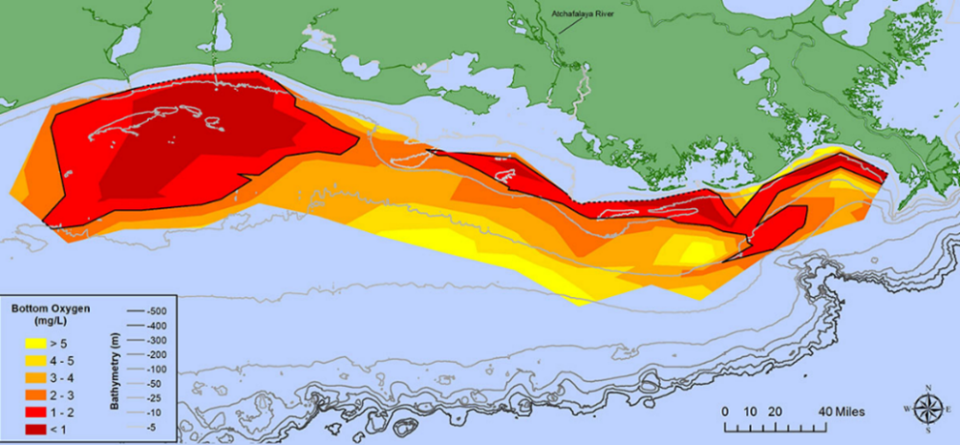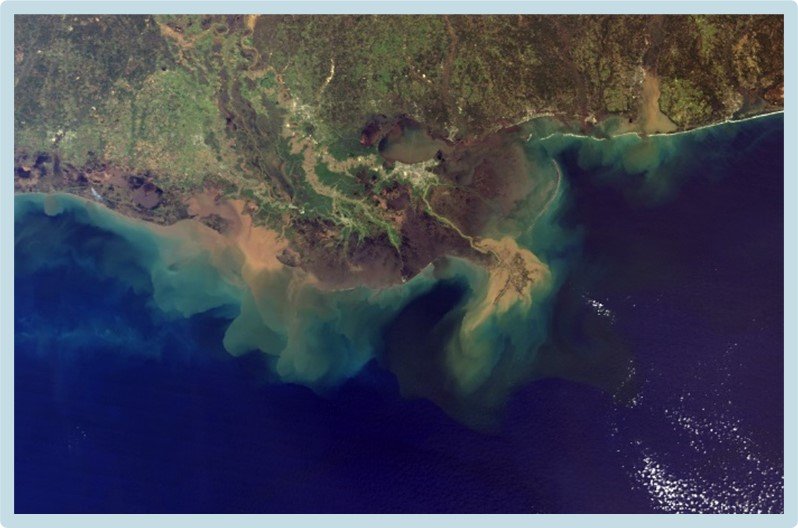Hypoxia 101
What is Hypoxia?
Hypoxia, or low levels of dissolved oxygen (less than 2-3 milligrams of oxygen per liter of water), occurs in waters all over the world. A variety of factors - including the effects of excess nutrients and waterbody stratification (layering) due to saline or temperature gradients - can create hypoxic conditions. Hypoxia can have detrimental effects on the ecological and economic health of impacted areas. Excess nutrients delivered to a waterbody can lead to both overgrowth of algae and eutrophication. As dead algae decompose, oxygen is consumed in the process, resulting in low levels of oxygen in the water. In some cases, large areas of water may become hypoxic. These areas are often called "dead zones" because they are unable to sustain normal populations of fish, shellfish, corals, and other aquatic life (NOAA 2021; ESA N.D.).
When and Where Does Hypoxia Occur?
Hypoxia occurs naturally but has increased since the 20th century due to human activity. Hypoxic conditions have been reported worldwide (Diaz and Rosenburg 2008). They occur most often in estuaries and coastal waters, but also in inland lakes, rivers, and streams (Jean-Philippe et al. 2016). Hypoxia often occurs in shallow coastal areas associated with developed watersheds that export large quantities of nutrients in runoff (Diaz and Rosenburg 2008). Climate change may increase the occurrence of hypoxic conditions. More frequent, intense storms and warming waters can lead to increased stratification of the water column, increased nutrient input, and diminished oxygen capacity (Rabalais et al. 2010).
Dead Zones Worldwide
Smaller areas experiencing periodic hypoxia can grow into dead zones if contributing factors are not addressed. Dead zones have spread exponentially since the 1960s and have been reported in more than 400 receiving waters, affecting more than 245,000 km2 worldwide (Diaz and Rosenburg 2008).
Dead Zones in the United States

Credit: N. Rabalais, LSU/LUMCON (NOAA 2021)
https://oceanservice.noaa.gov/facts/deadzone.html
Dead zones are found throughout the United States, mostly along coastlines (Diaz and Rosenburg 2008). The largest dead zone in the United States forms each summer in the Gulf of America over the Louisiana/Texas continental shelf (LUMCON 2018); at its largest the zone was measured at over 22,000 km2 in 2017 (USEPA 2022). This area contains almost half of the nation's coastal wetlands and supports fisheries generating $1 billion/year (NCCOS 2017). Another dead zone forms in the main stem of the Chesapeake Bay each summer (up to 40% of its area and 5% of its volume) (VIMS 2021).
How Does Hypoxia Occur in the Gulf of America?

Credit: NASA Earth Observatory
The amount of oxygen in a waterbody varies naturally due to certain biological and chemical processes, changing seasons, temperature, and atmospheric processes. Each summer, seasonal stratification in the Gulf of America results in less oxygen because of the waters differing densities at different depths. When water flows from the Mississippi/Atchafalaya River into the Gulf, the less dense freshwater remains above the denser saline seawater and create layers that prevent the mixing of oxygen-rich surface water with oxygen-poor bottom water. Without mixing, oxygen in the bottom water is low and the hypoxic condition remains (NOAA 2021).
References
- Diaz, R.J., and R. Rosenberg. 2008. Spreading dead zones and consequences for marine ecosystems. Science 321(5891):926-929.
- ESA (Ecological Society of America). No Date. Hypoxia. https://www.esa.org/esa/wp-content/uploads/2012/12/hypoxia.pdf.
- FAO (Food and Agriculture Organization). 2020. The State of World Fisheries and Aquaculture 2020. Sustainability in Action. Food and Agriculture Organization of the United Nations, Rome.
- Hong, P. , Schmid, B. , De Laender, F. , Eisenhauer, N. , Zhang, X. , Chen, H. , et al. 2022. Biodiversity promotes ecosystem functioning despite environmental change. Ecology Letters 25: 555–569. https://pmc.ncbi.nlm.nih.gov/articles/PMC9300022/
- Jean-Philippe, J. , P. Francus, A. Normandeau, F. Lapointe, M.E. Perga, A. Ojala, A. Schimmelmann, and B. Zolitschka. 2016. Global spread of hypoxia in freshwater ecosystems during the last three centuries is caused by rising local human pressure. Global Change Biology 22(4):1481-1489.
- LUMCON (Louisiana Universities Marine Consortium). 2018. About Hypoxia. https://gulfhypoxia.net/about-hypoxia/.
- NCCOS (National Centers for Coastal Ocean Science). 2017. Northern Gulf of America Ecosystems & Hypoxia Assessment (NGOMEX) Background.
- NOAA (National Oceanic and Atmospheric Administration). 2021. Hypoxia. https://oceanservice.noaa.gov/hazards/hypoxia/.
- Rabalais, N.N., R.J. Diaz, L.A. Levin, R.E. Turner, D. Gilbert, and J. Zhang. 2010. Dynamics and distribution of natural and human-caused hypoxia. Biogeosciences 7:585–619.
- Rao, Y.R., T. Howell, S.B. Watson, and S. Abernethy. 2014. On hypoxia and fish kills along the north shore of Lake Erie. Journal of Great Lakes Research 40(1):187–191.
- USEPA (U.S. Environmental Protection Agency). 2022. Northern Gulf of America Hypoxic Zone. https://www.epa.gov/ms-htf/northern-gulf-america-hypoxic-zone.
- VIMS (Virginia Institute of Marine Science). 2021. VIMS dead-zone report card reflects extended season. https://www.vims.edu/newsandevents/topstories/2021/dz_report_card_2021.php.
